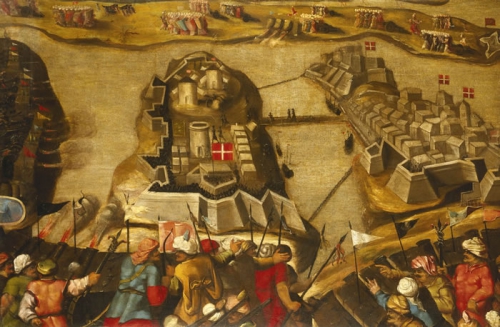dimanche, 01 janvier 2017
The Siege of Malta Knights of St John vs Ottoman Empire

The Siege of Malta Knights of St John vs Ottoman Empire
This show looks at the rising Ottoman Empire attempts to conquer all Mediterranean trade routes, but the tiny island of Malta stands in its way. This island is also home to the fiercest knights, the Order of St. John, or Knights Hospitaller. 8,000 Knights and native Maltese fended off approx 48,000 Turkish warriors during the Siege of Malta. After the heroic stand, the capital of Malta is named after the commanding general, Jean de Valette.
The Siege of Malta (also known as the Great Siege of Malta) took place in 1565 when the Ottoman Empire invaded the island, then held by the Knights Hospitaller (also known as the Sovereign Order of Saint John of Jerusalem of Rhodes and of Malta, Knights of Malta, Knights of Rhodes, and Chevaliers of Malta).
The Knights, together with between 400 Maltese men, women and children and approximately 2,000 footsoldiers won the siege, one of the bloodiest and most fiercely contested in history, and one which became one of the most celebrated events in sixteenth-century Europe. Voltaire said, "Nothing is better known than the siege of Malta," and it undoubtedly contributed to the eventual erosion of the European perception of Ottoman invincibility and marked a new phase in Spanish domination of the Mediterranean. The siege was the climax of an escalating contest between a Christian alliance and the Ottoman Empire for control of the Mediterranean, a contest that included Turkish admiral and privateer Dragut's attack on Malta in 1551, and the Ottoman utter destruction of an allied Christian fleet at the Battle of Djerba in 1560.
The number of casualties is in as much dispute as the number of invaders. Balbi gives 35,000 Ottoman deaths, which seems implausible, Bosio 30,000 casualties (including sailors). However modern estimations from military historians using Turkish archives have put the number of casualties at 10,000 from combat and disease, though it is generally agreed that there were likely far more losses amongst the various volunteers and pirates, which the Turkish sources would not have noted. The knights lost a third of their number, and Malta lost a third of its inhabitants. Birgu and Senglea were essentially leveled. Still, 9,000 Christians, most of them Maltese, had managed to withstand a siege of more than four months in the hot summer, despite enduring a bombardment of some 130,000 cannonballs.
Jean De Valette, Grand Master of the knights of Malta, had a key influence in the victory against Ottomans with his example and his ability to encourage and hold together people as one man. This example had a major impact, because the kings of Europe realized that the only way to win against the Ottomans was to stop wars between them and form alliances; the result was the vast union of forces against Ottomans at the Battle of Lepanto few years later. Such was the gratitude of Europe for the knights' heroic defense that money soon began pouring into the island, allowing de Valette to construct a fortified city, Valletta, on Mt. Sciberras. His intent was to deny the position to any future enemies. La Valette himself died in 1568 after a hunting trip in Buskett.
The Ottomans never attempted to besiege Malta again. The failure of the siege did nothing to reverse the increasing dominance of Ottoman naval power in the Mediterranean, but in following a string of Christian naval defeats, such as at the Battle of Djerba, it did deny Ottoman forces the strategically vital island base in the centre of the sea which would have allowed them to launch ever deeper strikes into the belly of Europe.
17:36 Publié dans Histoire, Militaria | Lien permanent | Commentaires (0) | Tags : malte, siège de malte, 16ème siècle, histoire, ordre de malte, ordre de saint jean, chevalerie, militaria |  |
|  del.icio.us |
del.icio.us |  |
|  Digg |
Digg | ![]() Facebook
Facebook


